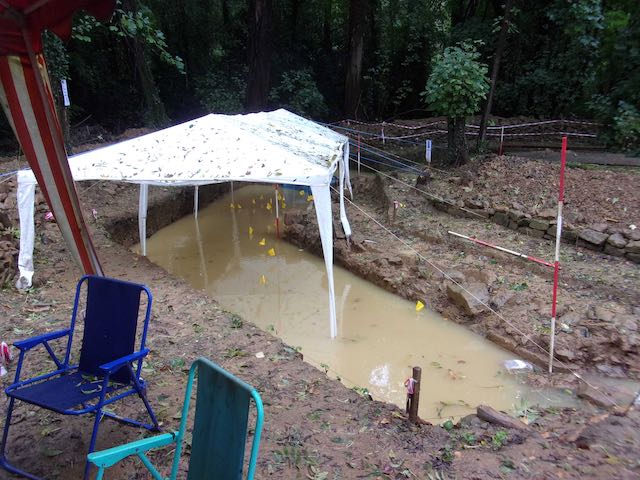

Thanks to Christopher for braving the storm to capture these images, we're really going to need that bridge
Some of our local volunteers
popped over to help with the mopping up and as the pump was taking a
while to get going they were squeezed onto the one metre wide baulk
that had been left for accessing the island from the south. This
proved quite productive whilst up at the finds department, well if
you are wet already you might as well get wetter, we did some bulk
washing of tile and some bones plus Verna made a sensational
discovery badged up as 'Stars in their eyes' in our Instagram feed.


All primed and ready to go, but an awful lot of water to shift. In the meantime Helen, John and Ian cling precariously to the sole remaining area above water.
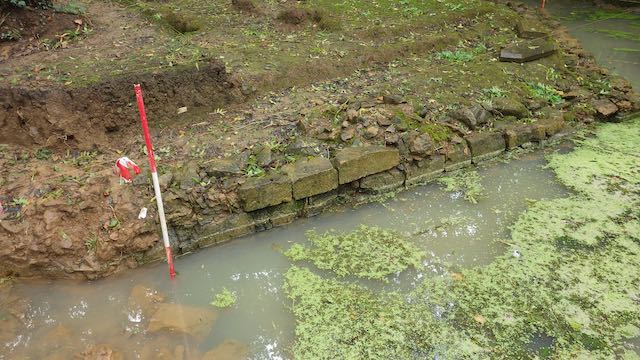
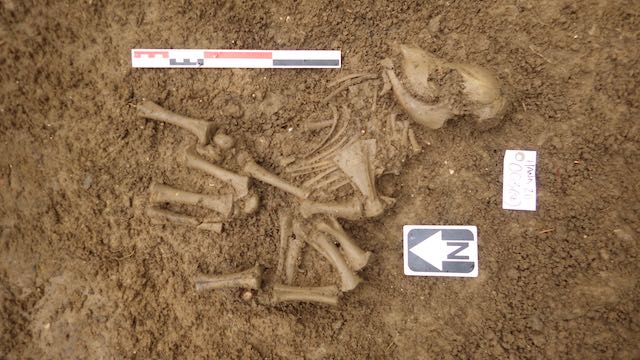
After a day of pumping the level has dropped by roughly10cm right round the island and John has completed the excavation of the 'Beast of Hanwell'.
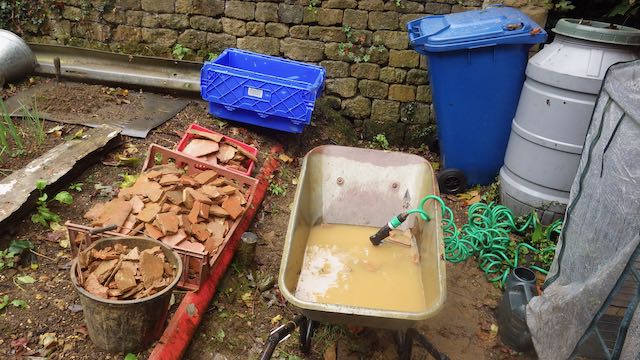
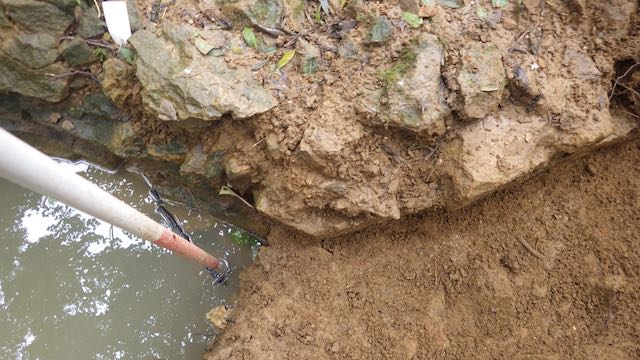
Other highlights were the washing of around 50kg of roof tile... wet, and the uncovering of the last corner of the octagon... sharp.
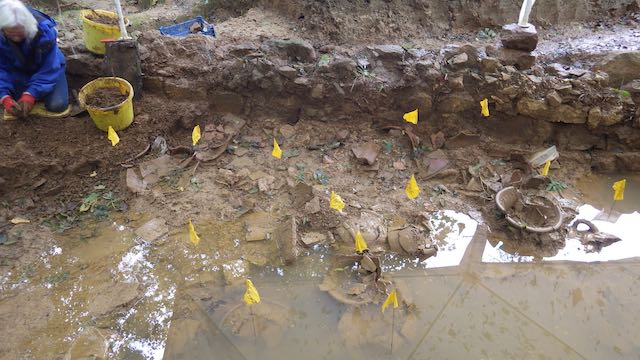
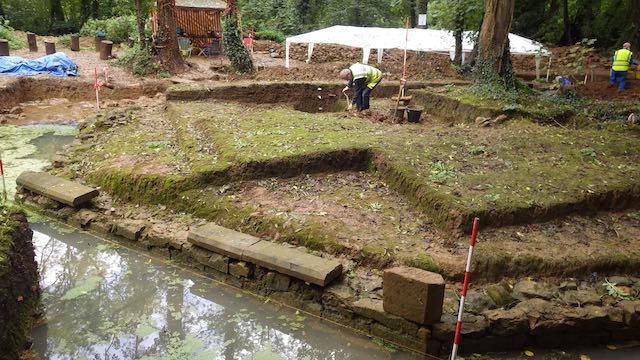
By the second day we were able to concentrate on just pumping out the eastern part of the site and it was quite strange to see our pots emerging from the receding waters.
Whilst waiting for them to go down I indulged in a little more anastylosis (I can't get enough of it) whilst Alan returned to the investigation of the centre of the island.
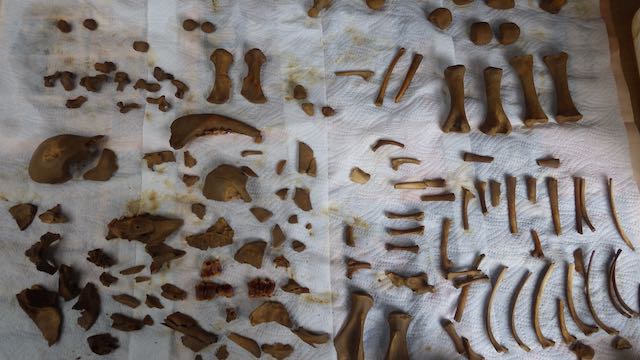
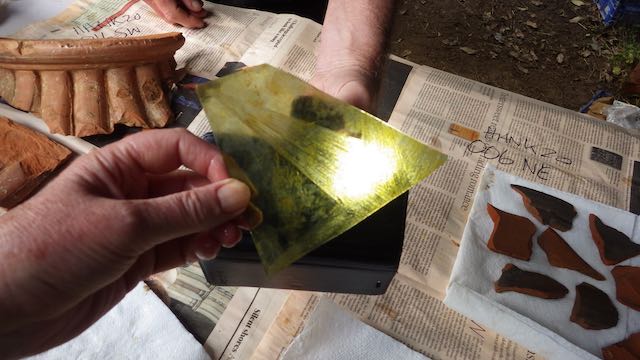
Up at the finds department the beast turned into a badger... who buries a badger? Then... hang on, what's this pattern on this piece of window glass?
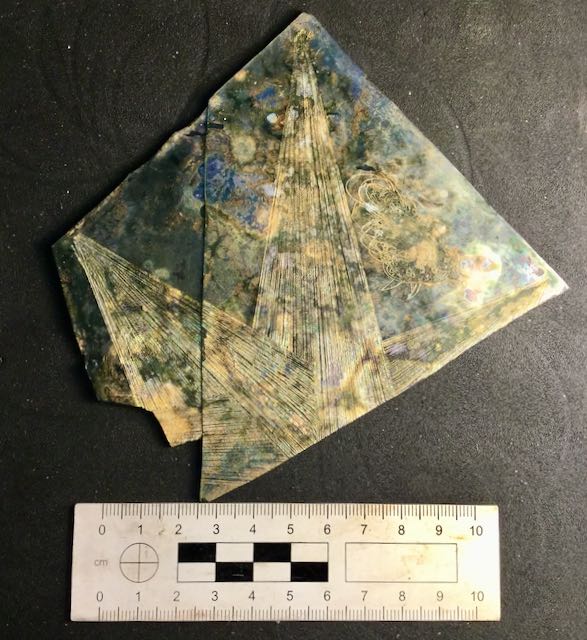
It's an engraved eight pointed star defined by a series of finely cut lines radiating from each point... wow!


All primed and ready to go, but an awful lot of water to shift. In the meantime Helen, John and Ian cling precariously to the sole remaining area above water.


After a day of pumping the level has dropped by roughly10cm right round the island and John has completed the excavation of the 'Beast of Hanwell'.


Other highlights were the washing of around 50kg of roof tile... wet, and the uncovering of the last corner of the octagon... sharp.


By the second day we were able to concentrate on just pumping out the eastern part of the site and it was quite strange to see our pots emerging from the receding waters.
Whilst waiting for them to go down I indulged in a little more anastylosis (I can't get enough of it) whilst Alan returned to the investigation of the centre of the island.


Up at the finds department the beast turned into a badger... who buries a badger? Then... hang on, what's this pattern on this piece of window glass?

It's an engraved eight pointed star defined by a series of finely cut lines radiating from each point... wow!
The second week in October
was the much delayed London Hat Week so as we were down there
anyway I took the opportunity to visit both the V&A and the
British Museum to search for stars and commune with other
significant artifacts from our period. Whilst the V&A had
most galleries open and one was free to wander at leisure the BM
had a ridiculous one way system and only allowed access to the
ground floor, very disappointing.
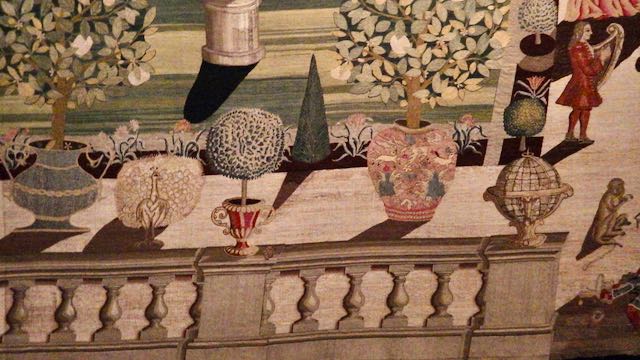
Embroidery from Stoke Edith. Herefordshire 1710 - 1720, showing elements of a formal garden with some wonderful pots, look at those colours.

More late seventeenth-century glassware to admire, all in the 'Britain 1500 - 1760' gallery at the V&A.
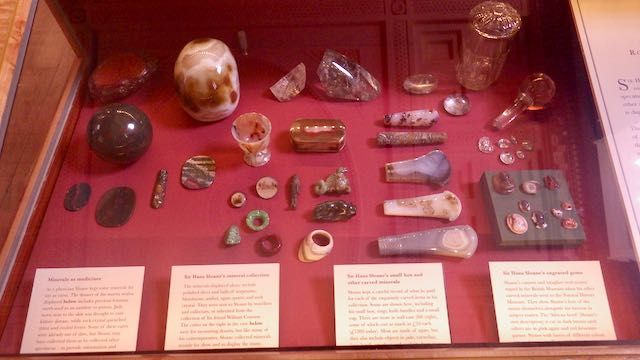
In the 'Enlightenment' gallery at the BM we have Sir Hans Sloane's collection of polished rocks, including some cutlery handles, no doubt Sir Anthony's collection would have been similar.

Embroidery from Stoke Edith. Herefordshire 1710 - 1720, showing elements of a formal garden with some wonderful pots, look at those colours.

More late seventeenth-century glassware to admire, all in the 'Britain 1500 - 1760' gallery at the V&A.

In the 'Enlightenment' gallery at the BM we have Sir Hans Sloane's collection of polished rocks, including some cutlery handles, no doubt Sir Anthony's collection would have been similar.
As we moved on through
the month our campaign of pumping continued to the point
where we were able to get onto the last remaining portion of
rubble (009) to start drawing it. However, everything else
remained pretty damp so we transferred some of our work
force to the centre of the island in a last ditch attempt to
identify the course of any in-coming pipework or out-going
drains. As attendance at our regular Monday and
Tuesday sessions had jumped to around a dozen... don't talk
to me about car parking, and since the storm it was obvious
that putting a cover over part of the site was useless, we
moved the marquee onto higher ground to give additional
shelter for everyone. In a further move to promote
social distancing we reopened two nearby trenches and indeed
extended them. The first, HAND, also known as 'the second
sluice', had become increasingly boggy so John made an
excellent job of, as they used to say in the US, 'draining
the swamp'. We also extended the trench a further metre to
the west to try and understand the odd complex of walls in
the approach channel. The other area returned to was HANL,
an area including the remnants of a wall flanking the
terraced walkway south of the water parterre. This trench
was also extended, this time to the east, to pick up another
area of large rubble and a not so old tin plate.
As most volunteers had not had an opportunity to tour the lower part of the valley we laid on a brief excursion to visit the remaining dams and the meadow on the south side of the valley to admire assorted earthworks. In a brief detour we took a look at the site used by a small contemporary, but unwanted, group of party goers. From the point of view of those archaeologists who study early transient populations of hunter / gatherers this was quite interesting with remains of a central fire and logs and branches pulled together to create temporary seating. Of interest to the criminologist was evidence of alcohol and drug use but strangest of all, and surely of some ritual significance, yes I know, a term much over-used in the past by archaeologists, but what else could it be, a bunch of fresh lilies.

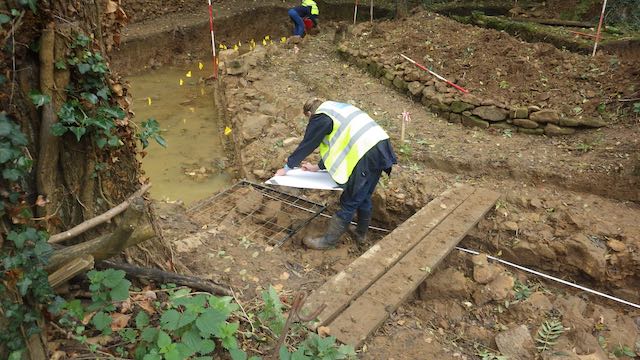
Our new, expanded shelter and social facility, pull up a log and sit down. Helen makes a start of drawing the final stretch of rubble
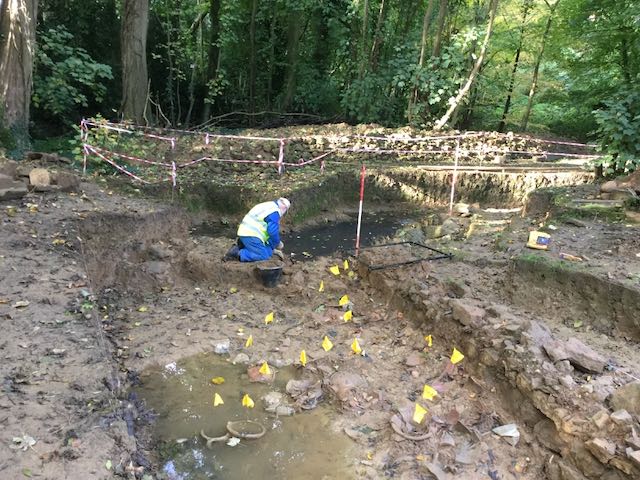

Ian continues removing the last section of baulk whilst Amber gets to grips with drawing the south eastern section of walling.

Some un-civil engineering as John begins to drain the swamp
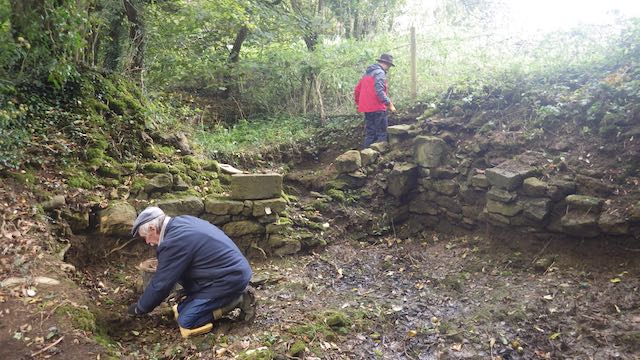
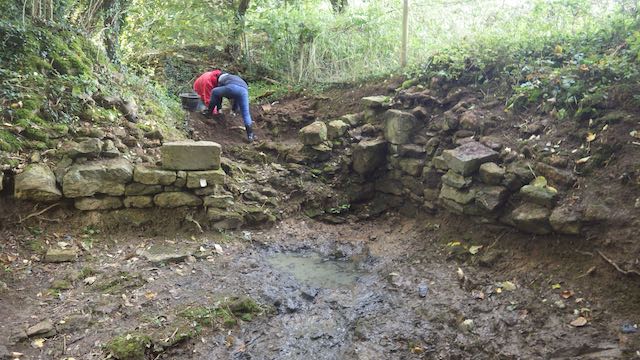
Andries and Paolo undertake more archaeological weeding. The following day we extend the trench ever westwards,
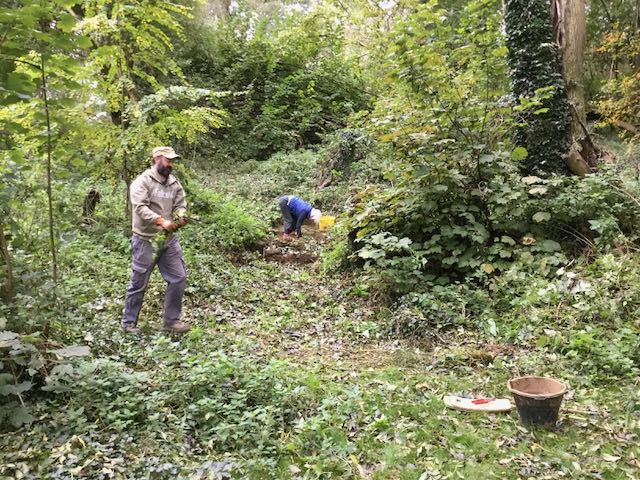

Meanwhile Chris and James, after some severe nettle chopping start to explore the line of the wall heading east...
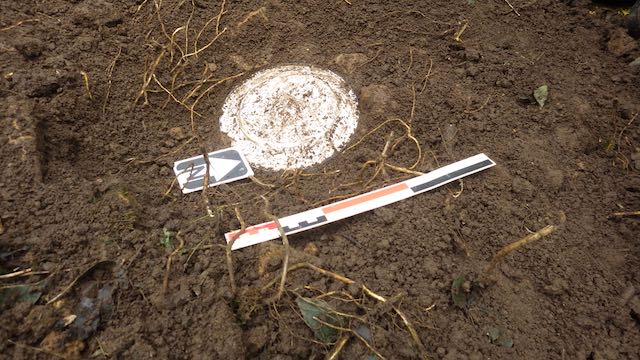
... but it was John who made the find of the week, a well preserved enameled tin plate marked on the base FALCON, HONG KONG
( In the 1920’s J.Kleiner & Sons established the name and manufactured Falcon Enamelware in England. As the production cost increased, J.Kleiner & Sons moved their production to Hong Kong in 1972 )
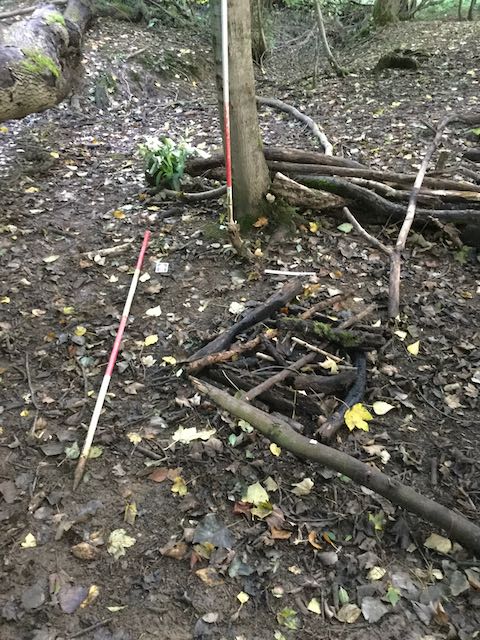
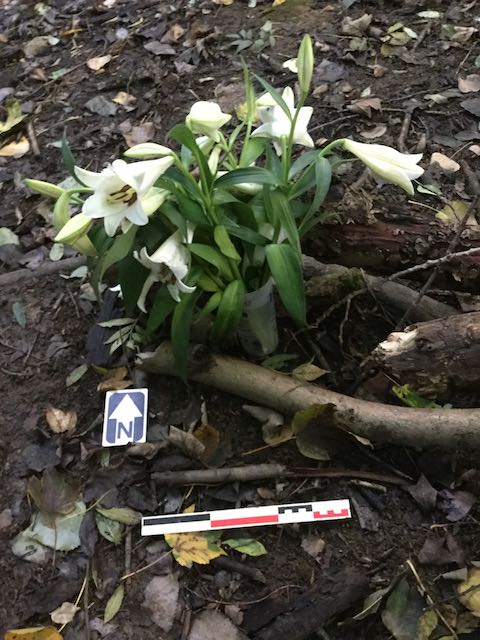
Our outdoor yet probably illegal party venue with fire and flowers.
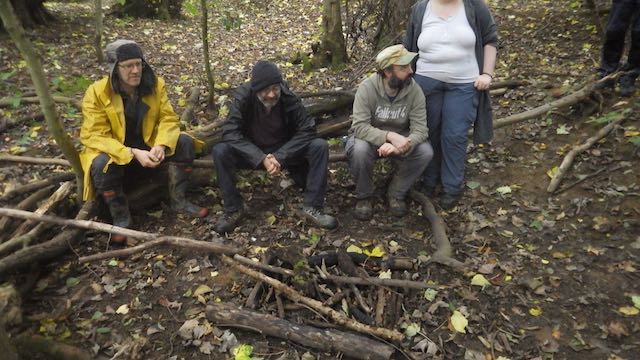
Experimental archaeology in action as some of our volunteers take on the role of party-goers, note, no drugs or alcohol were consumed during this reconstruction...
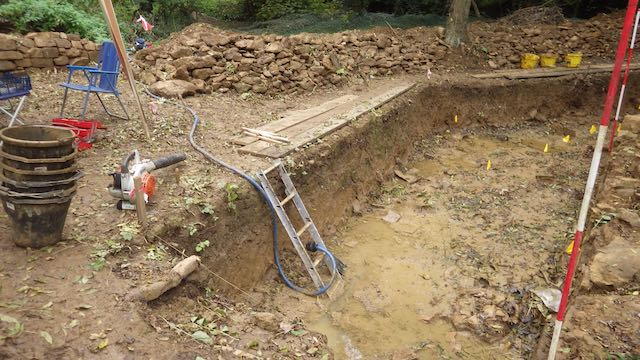
The pump and the leaf blower and the aftermath of having them in use.
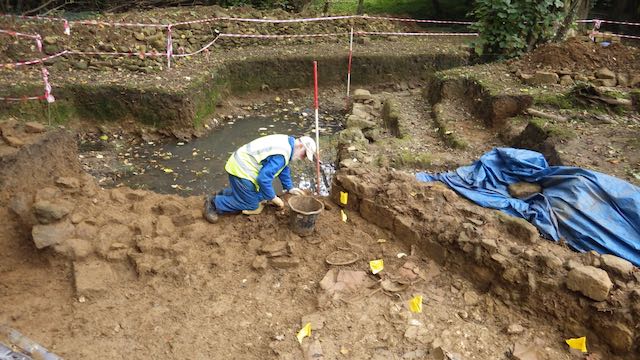
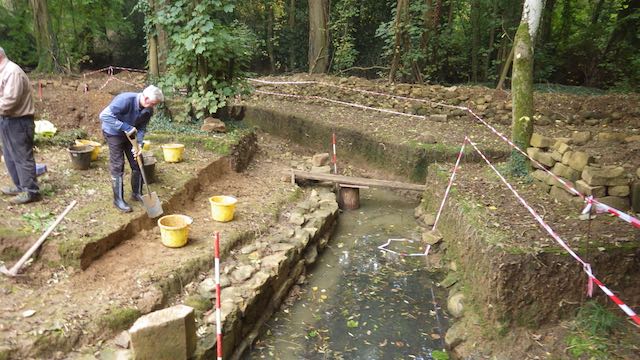
Ian examines pot number 53 whilst Peter and John settle in to the spadework necessary up top. Note the new bridge on the west side.
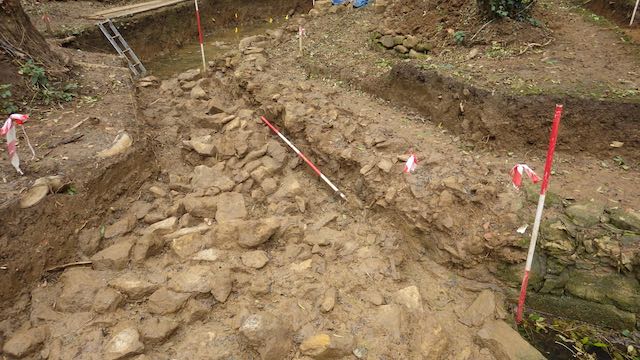
The last expanse of 009, drawn, photographed and ready to lift.
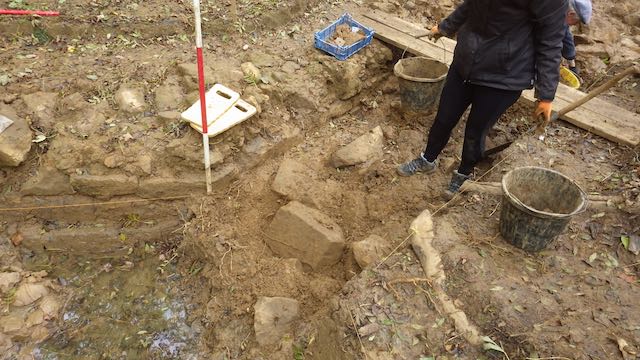
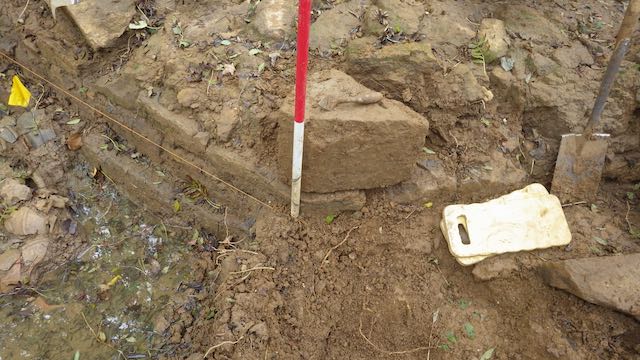
Rosie made a start and uncovered fairly rapidly a new corner block that was with equal rapidly reinstalled.
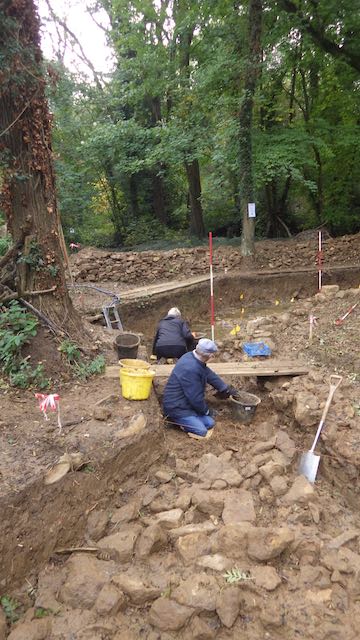
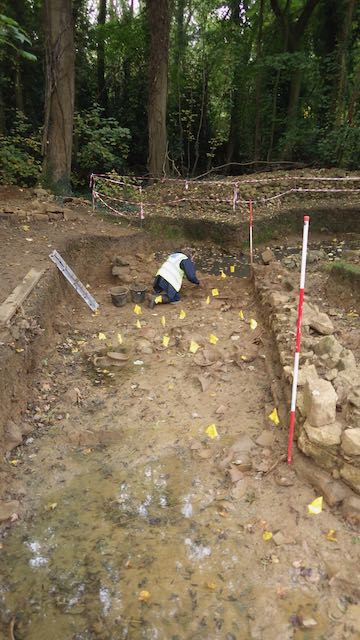
Andries starts to sort out his share of 009. Helen tries to avoid sinking into silt.
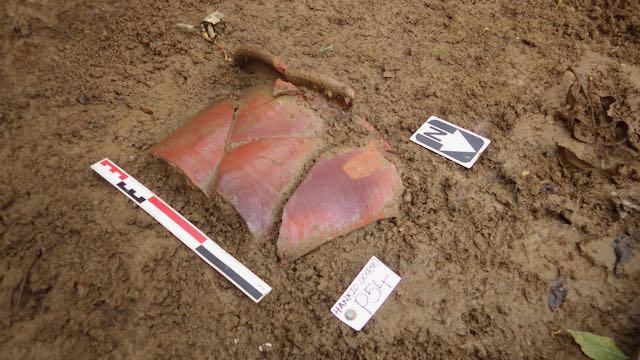
... and we are ready to start lifting pots, P54, a straight forward flower pot will be the first to go.
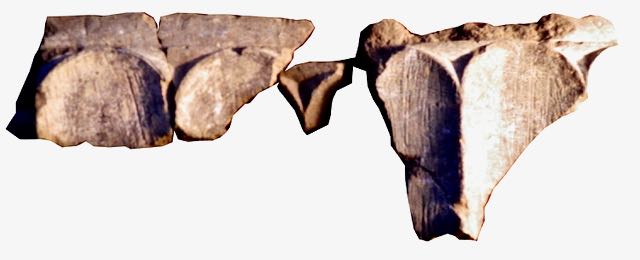
Up in the finds department these fragments are washed and put together and Verna spots they are part of a large diameter steep sided bowl, possibly the lowest tier of the fountain?
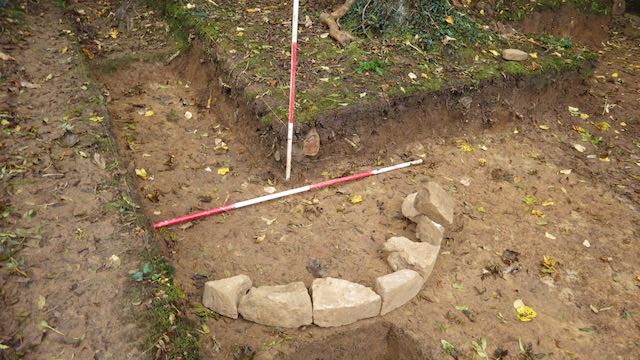
We have had a significant number of blocks with a curved face that can be assembled as above to form what I believe to have been the fountain's base.
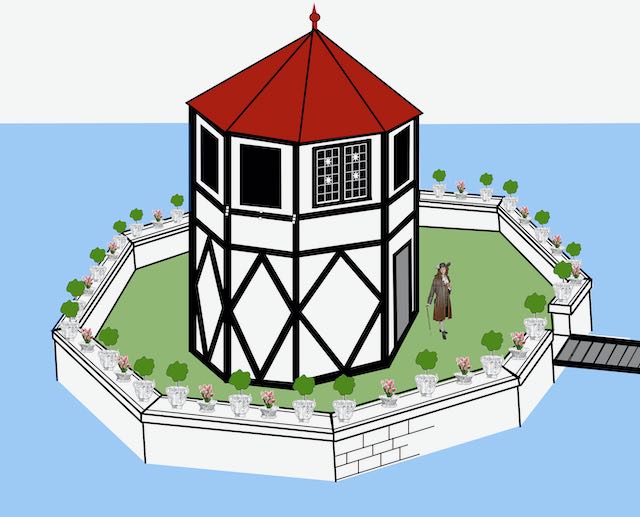
..., and here's a first look at my first attempt to build a House of Diversion, at least on paper.
... and here, for anyone interested, are a few notes on the thinking behind this image:
A key question must be how confident are we that the site excavated is in fact the location of the House of Diversion as described by Plot? To recap Plot’s description:
There are some other Water-works at the same Sir Anthony Cope’s, in a House of Diversion built in a small Island on one of the Fish-ponds , Eastward of his House, where a Ball is tost by a Column of Water and artificial Showers descend at pleasure; within which they can yet so place a Candle, that though one would think it must needs be overwhelmed with Water, it shall not be extinguish’d &c
We are certainly on an island in the right location relative to the house and as it is described as ‘built’ we must assume a structure with walls and a roof inside which are the waterworks. Putting fountains and other water-powered special effects indoors is not particularly unusual, we saw this at Enstone and Wilton, although in these instances the structures were elaborately decorated grottoes. Perhaps a relatively plain setting for the Hanwell waterworks underlines a more studied approach to the engineering involved.
The evidence we have as to the precise conformation of the building is all rather circumstantial and based almost entirely on destruction debris recovered from the moat. The presence of a high proportion of tapered ridge tiles suggests a pyramidal roof arising from a square or octagonal floor plan. The presence of large quantities of wall plaster formerly pressed against timber laths indicates a timber framed building with evidence of a ‘pebble-dashed’ effect on the outside and combed decoration on the inside. There is ample evidence for glazing with fine sheets of cylinder glass set within lead cames. The shaping of the surviving fragments of glass point towards a simple design of upright rectangular panels with at least one of them being marked with a large engraved star. This was a very unusual find and hints at decorative elements that match quite well with an interest in natural phenomena, indeed, may even constitute an invitation to observe the heavens through the windows of the House of Diversion. The floor levels were removed as part of the programme of leveling the island and filling in the moat but a number of thin carefully finished slabs were recovered. It is assumed that the fountain capable of suspending a ball in the air and creating descending showers was placed centrally within the building. Evidence for this includes a large portion of stone bowl with a diameter of 2m (6 feet) and pierced at three points for incoming pipework and a small copper alloy quill, a thin bore pipe used to create fine jets of water. Several finely shaped fragments of ironstone moulding were also excavated none of which would fit with any conventional architectural element of such domestic features as door or window surrounds. The fact that the fountain also had to provide descending showers suggests that there may have been some kind of superstructure, a simplified version of the canopy over the early seventeenth-century fountain at Trinity College, Cambridge springs to mind.
In considering the ground plan of the building the existence of the small octagonal banqueting house within an octagonal moat at Hunstanton Hall, Norfolk is perhaps the most suggestive parallel for an eight-sided structure and given the setting and the likely presence of a central fountain on a circular base this is probably the most aesthetically satisfying arrangement. The overall dimensions remain a similarly speculative matter although given that the diameter of the fountain base would have been around 2.5m (8 feet) and allowing room for circulation whilst avoiding occasional splashing then a minimum diameter of 6m (20 feet) for the whole building seems about right. If the fountain was to perform such tricks as tossing a ball on a column off water and given the possibility of a fairly elaborate superstructure, then we should perhaps cater for a minimum of 4m (12 feet ) for the display to show at its best. Allowing for clearance above this we are considering a structure equivalent to a building of two stories albeit open to the roof on the inside. Such a timber framed tower finds parallels in contemporary dovecots such as the example at Wichenford,
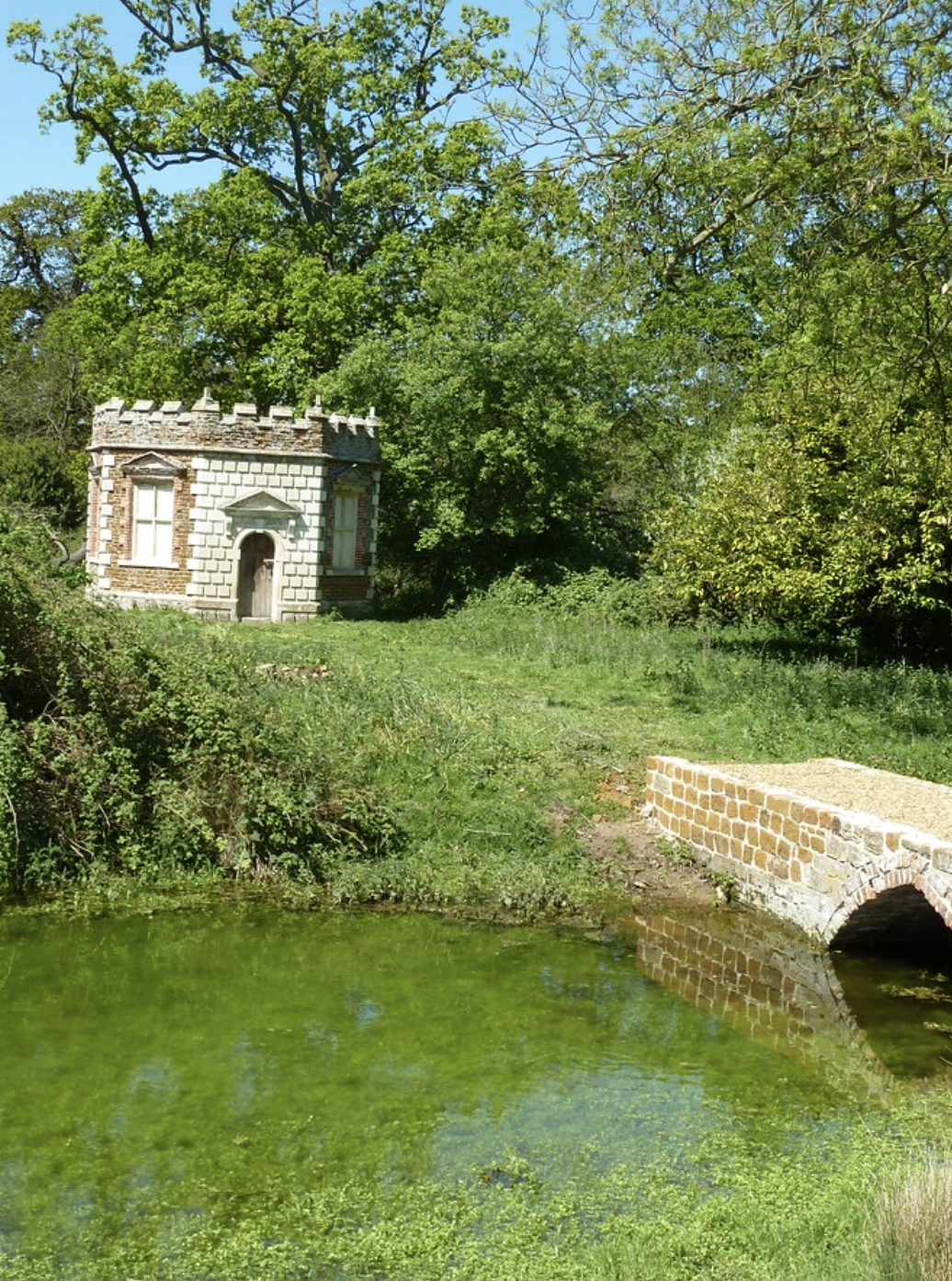

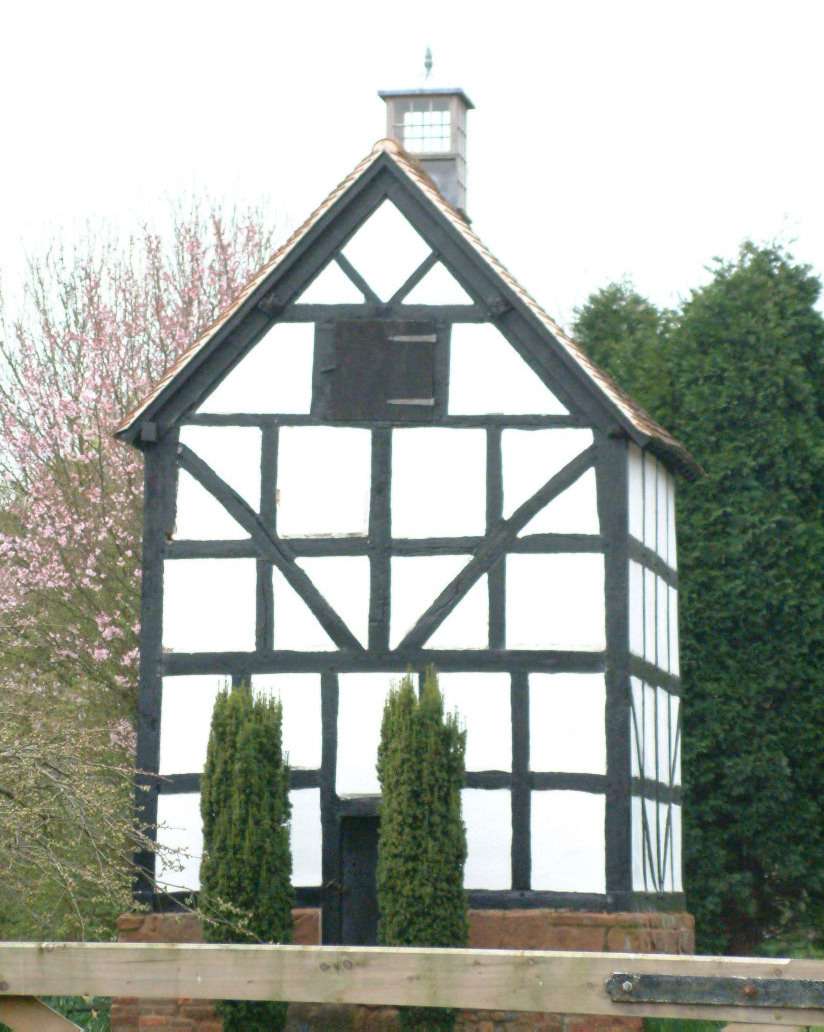
Inspiration: The Octagon, Hunstanton, The fountain, Trinity College, Cambridge and the Dovecote at Wichenford.
As most volunteers had not had an opportunity to tour the lower part of the valley we laid on a brief excursion to visit the remaining dams and the meadow on the south side of the valley to admire assorted earthworks. In a brief detour we took a look at the site used by a small contemporary, but unwanted, group of party goers. From the point of view of those archaeologists who study early transient populations of hunter / gatherers this was quite interesting with remains of a central fire and logs and branches pulled together to create temporary seating. Of interest to the criminologist was evidence of alcohol and drug use but strangest of all, and surely of some ritual significance, yes I know, a term much over-used in the past by archaeologists, but what else could it be, a bunch of fresh lilies.


Our new, expanded shelter and social facility, pull up a log and sit down. Helen makes a start of drawing the final stretch of rubble


Ian continues removing the last section of baulk whilst Amber gets to grips with drawing the south eastern section of walling.

Some un-civil engineering as John begins to drain the swamp


Andries and Paolo undertake more archaeological weeding. The following day we extend the trench ever westwards,


Meanwhile Chris and James, after some severe nettle chopping start to explore the line of the wall heading east...

... but it was John who made the find of the week, a well preserved enameled tin plate marked on the base FALCON, HONG KONG
( In the 1920’s J.Kleiner & Sons established the name and manufactured Falcon Enamelware in England. As the production cost increased, J.Kleiner & Sons moved their production to Hong Kong in 1972 )


Our outdoor yet probably illegal party venue with fire and flowers.

Experimental archaeology in action as some of our volunteers take on the role of party-goers, note, no drugs or alcohol were consumed during this reconstruction...
Pumping to keep water
levels down and blowing to shift the autumn leaves off
of the site became two all consuming interests. The
problem with excavating the silts as exposed in the
south east and eastern sections was that although when
troweled they presented quite a firm and compact
surface, even when under water, when walked upon they
rapidly turned into porridge. This meant increasingly
having to juggle planks around and use sheets of ply
(Thanks John) as surfaces to work from. Digging
resumed on top of the island in a last ditch attempt to
establish the presence of either in-coming pipework or
out-going drains, at least it's dry up there. Finally
the last area of destruction rubble, known universally
as 009, started to come up and below it, yes more pots.
In the odd idle moment I've been thinking about
reconstructing the House of Diversion, at least on
paper, with a view to commissioning a professional
artist to illustrate it for us. It's an exercise that
certainly promotes thinking and forces one to come to
some conclusions... see below.

The pump and the leaf blower and the aftermath of having them in use.


Ian examines pot number 53 whilst Peter and John settle in to the spadework necessary up top. Note the new bridge on the west side.

The last expanse of 009, drawn, photographed and ready to lift.


Rosie made a start and uncovered fairly rapidly a new corner block that was with equal rapidly reinstalled.


Andries starts to sort out his share of 009. Helen tries to avoid sinking into silt.

... and we are ready to start lifting pots, P54, a straight forward flower pot will be the first to go.

Up in the finds department these fragments are washed and put together and Verna spots they are part of a large diameter steep sided bowl, possibly the lowest tier of the fountain?

We have had a significant number of blocks with a curved face that can be assembled as above to form what I believe to have been the fountain's base.

..., and here's a first look at my first attempt to build a House of Diversion, at least on paper.
... and here, for anyone interested, are a few notes on the thinking behind this image:
Reconstructing
the ‘House of Diversion’
A key question must be how confident are we that the site excavated is in fact the location of the House of Diversion as described by Plot? To recap Plot’s description:
There are some other Water-works at the same Sir Anthony Cope’s, in a House of Diversion built in a small Island on one of the Fish-ponds , Eastward of his House, where a Ball is tost by a Column of Water and artificial Showers descend at pleasure; within which they can yet so place a Candle, that though one would think it must needs be overwhelmed with Water, it shall not be extinguish’d &c
We are certainly on an island in the right location relative to the house and as it is described as ‘built’ we must assume a structure with walls and a roof inside which are the waterworks. Putting fountains and other water-powered special effects indoors is not particularly unusual, we saw this at Enstone and Wilton, although in these instances the structures were elaborately decorated grottoes. Perhaps a relatively plain setting for the Hanwell waterworks underlines a more studied approach to the engineering involved.
The evidence we have as to the precise conformation of the building is all rather circumstantial and based almost entirely on destruction debris recovered from the moat. The presence of a high proportion of tapered ridge tiles suggests a pyramidal roof arising from a square or octagonal floor plan. The presence of large quantities of wall plaster formerly pressed against timber laths indicates a timber framed building with evidence of a ‘pebble-dashed’ effect on the outside and combed decoration on the inside. There is ample evidence for glazing with fine sheets of cylinder glass set within lead cames. The shaping of the surviving fragments of glass point towards a simple design of upright rectangular panels with at least one of them being marked with a large engraved star. This was a very unusual find and hints at decorative elements that match quite well with an interest in natural phenomena, indeed, may even constitute an invitation to observe the heavens through the windows of the House of Diversion. The floor levels were removed as part of the programme of leveling the island and filling in the moat but a number of thin carefully finished slabs were recovered. It is assumed that the fountain capable of suspending a ball in the air and creating descending showers was placed centrally within the building. Evidence for this includes a large portion of stone bowl with a diameter of 2m (6 feet) and pierced at three points for incoming pipework and a small copper alloy quill, a thin bore pipe used to create fine jets of water. Several finely shaped fragments of ironstone moulding were also excavated none of which would fit with any conventional architectural element of such domestic features as door or window surrounds. The fact that the fountain also had to provide descending showers suggests that there may have been some kind of superstructure, a simplified version of the canopy over the early seventeenth-century fountain at Trinity College, Cambridge springs to mind.
In considering the ground plan of the building the existence of the small octagonal banqueting house within an octagonal moat at Hunstanton Hall, Norfolk is perhaps the most suggestive parallel for an eight-sided structure and given the setting and the likely presence of a central fountain on a circular base this is probably the most aesthetically satisfying arrangement. The overall dimensions remain a similarly speculative matter although given that the diameter of the fountain base would have been around 2.5m (8 feet) and allowing room for circulation whilst avoiding occasional splashing then a minimum diameter of 6m (20 feet) for the whole building seems about right. If the fountain was to perform such tricks as tossing a ball on a column off water and given the possibility of a fairly elaborate superstructure, then we should perhaps cater for a minimum of 4m (12 feet ) for the display to show at its best. Allowing for clearance above this we are considering a structure equivalent to a building of two stories albeit open to the roof on the inside. Such a timber framed tower finds parallels in contemporary dovecots such as the example at Wichenford,



Inspiration: The Octagon, Hunstanton, The fountain, Trinity College, Cambridge and the Dovecote at Wichenford.
The last week of
the month was billed as the autumn 'Big Dig' and we
were hoping to welcome back loads of people who had
been with us back in the summer and were on their
half term break and were keen for more digging. As
it happened varying levels of restriction because of
Corona virus meant we weren't able to assemble the
full crew but even so, and despite the poor weather,
we had a very rewarding week with new discoveries
coming thick and fast, read on...
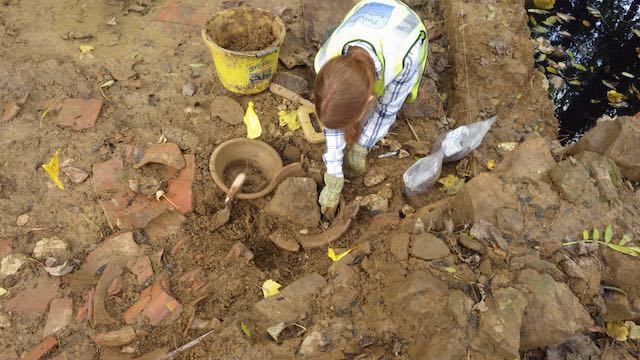
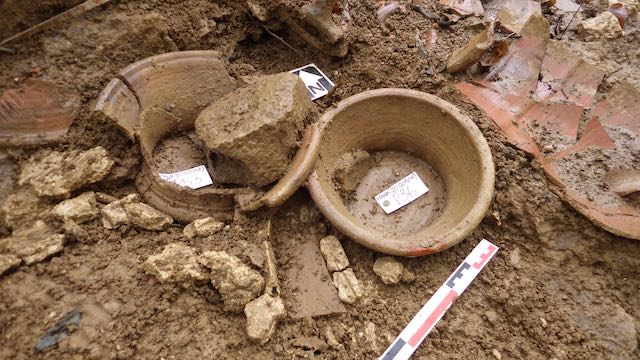
We were now in a position to start lifting pots and spiriting them away to the finds department. Jasmine is cleaning round pot 37, could it be, could it be?
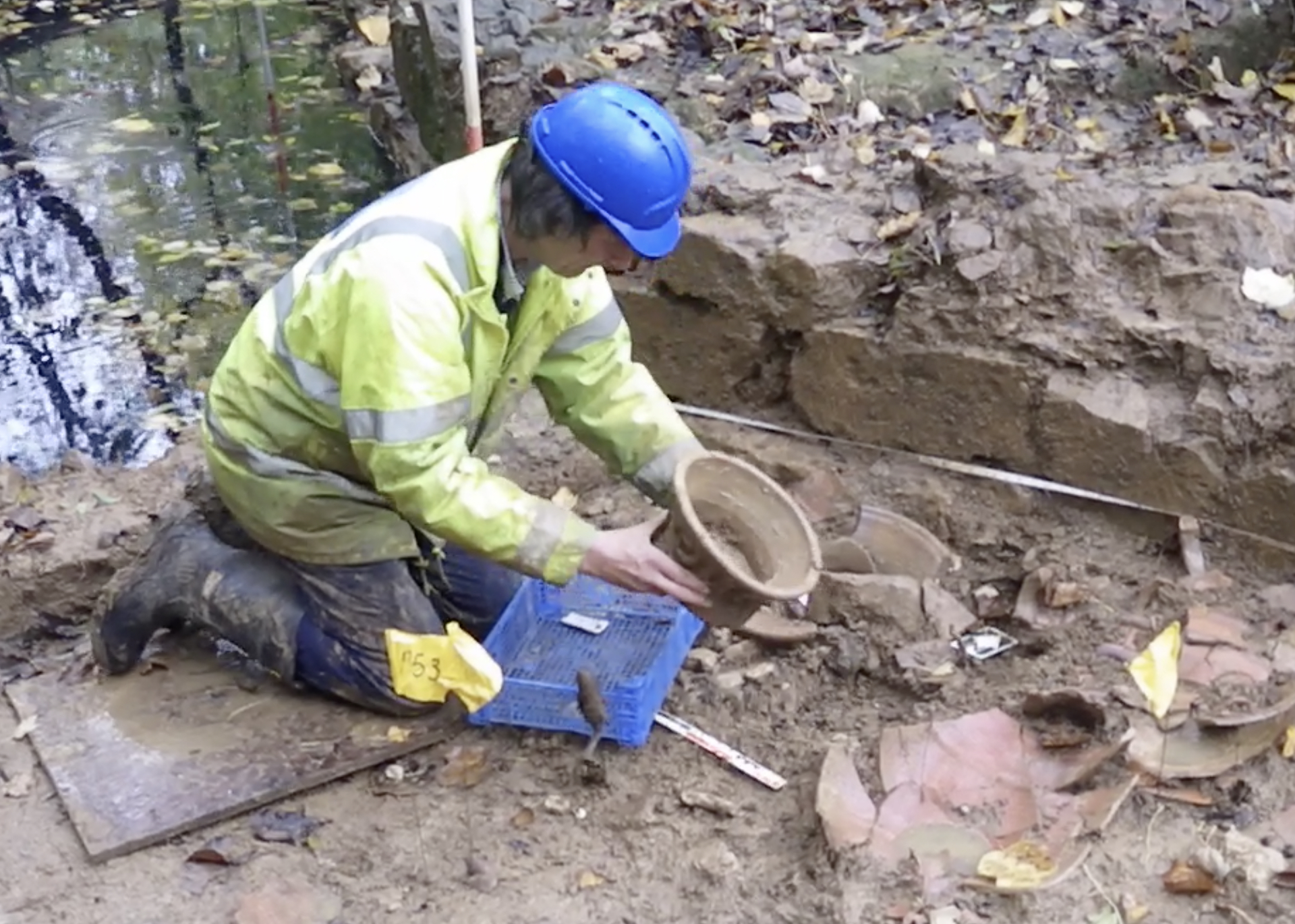
Yes, it was not only complete but intact, after being tossed into the moat nearly 350 years ago. As it happened Rowena, Christopher and a delegation from Banbury Museum were on hand to see it lifted.
(There's a movie of this moment on the Polyolbion Instagram account.)
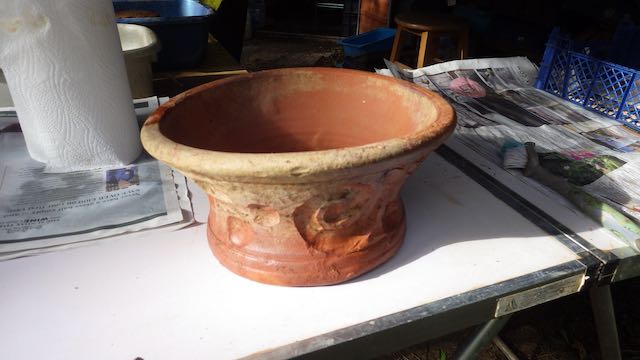
Here it is cleaned up.
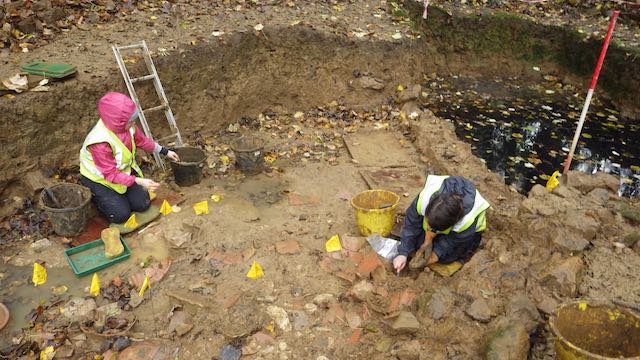
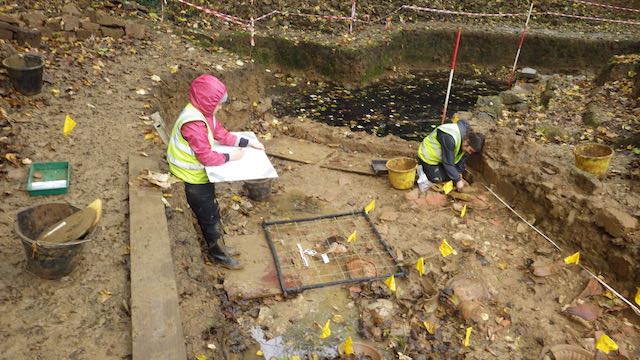
The procedure was pretty standardised by now: clean the pot, plan the pot, photograph the pot and lift the pot. Here are Maria and Pinelopi getting on with it.
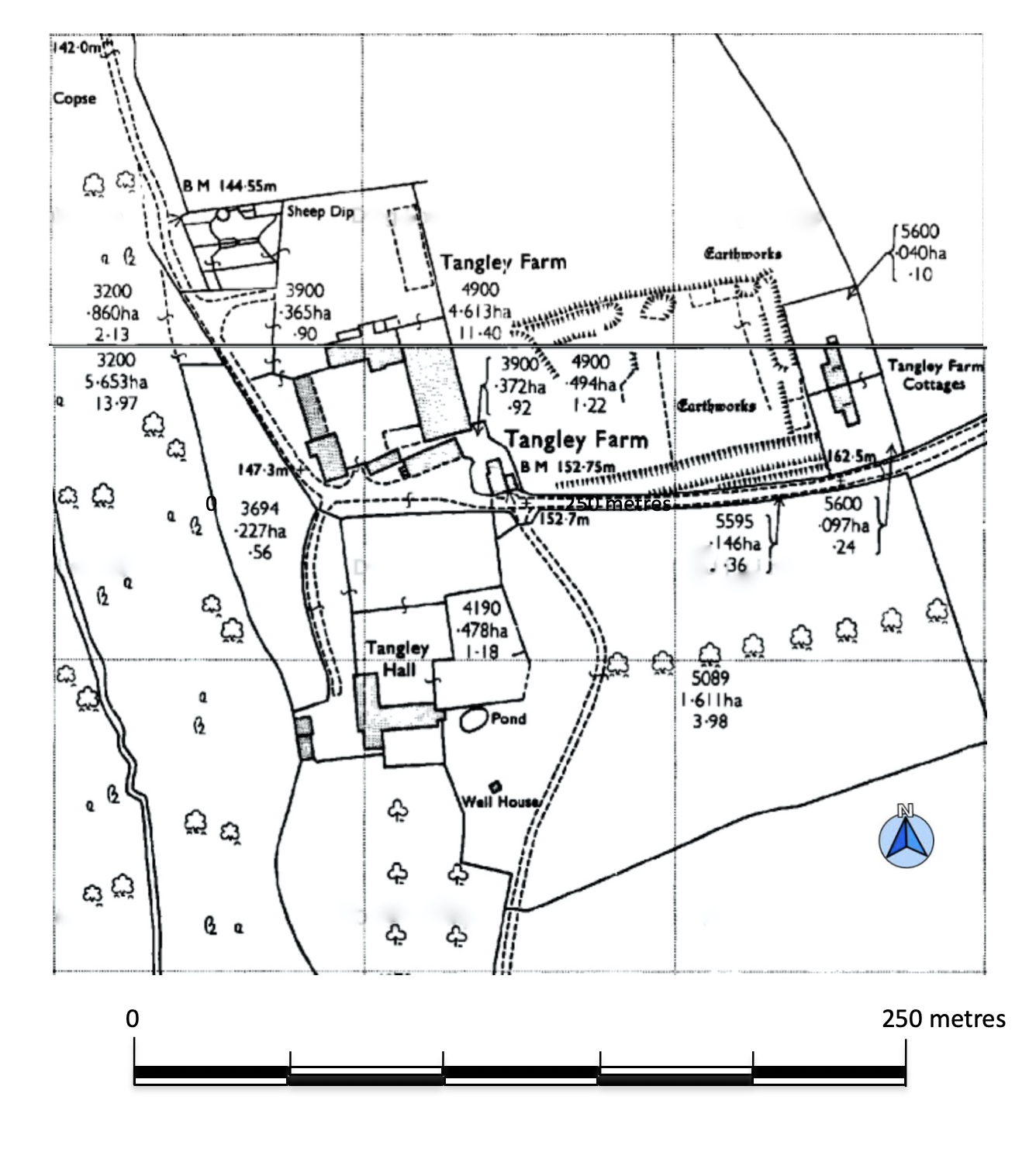
A site of special interest, Tangley with the earthworks of what must be another one of the Cope's gardens.
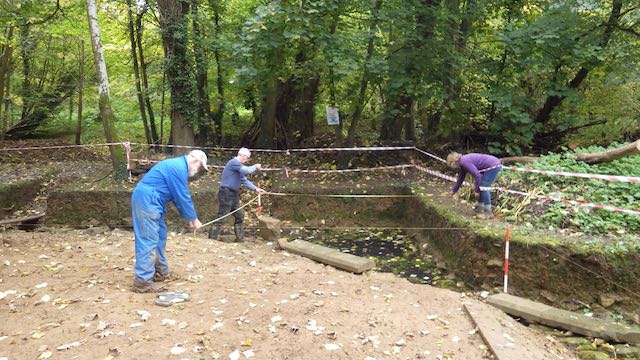
The crack tape crew in action working hard to produce:

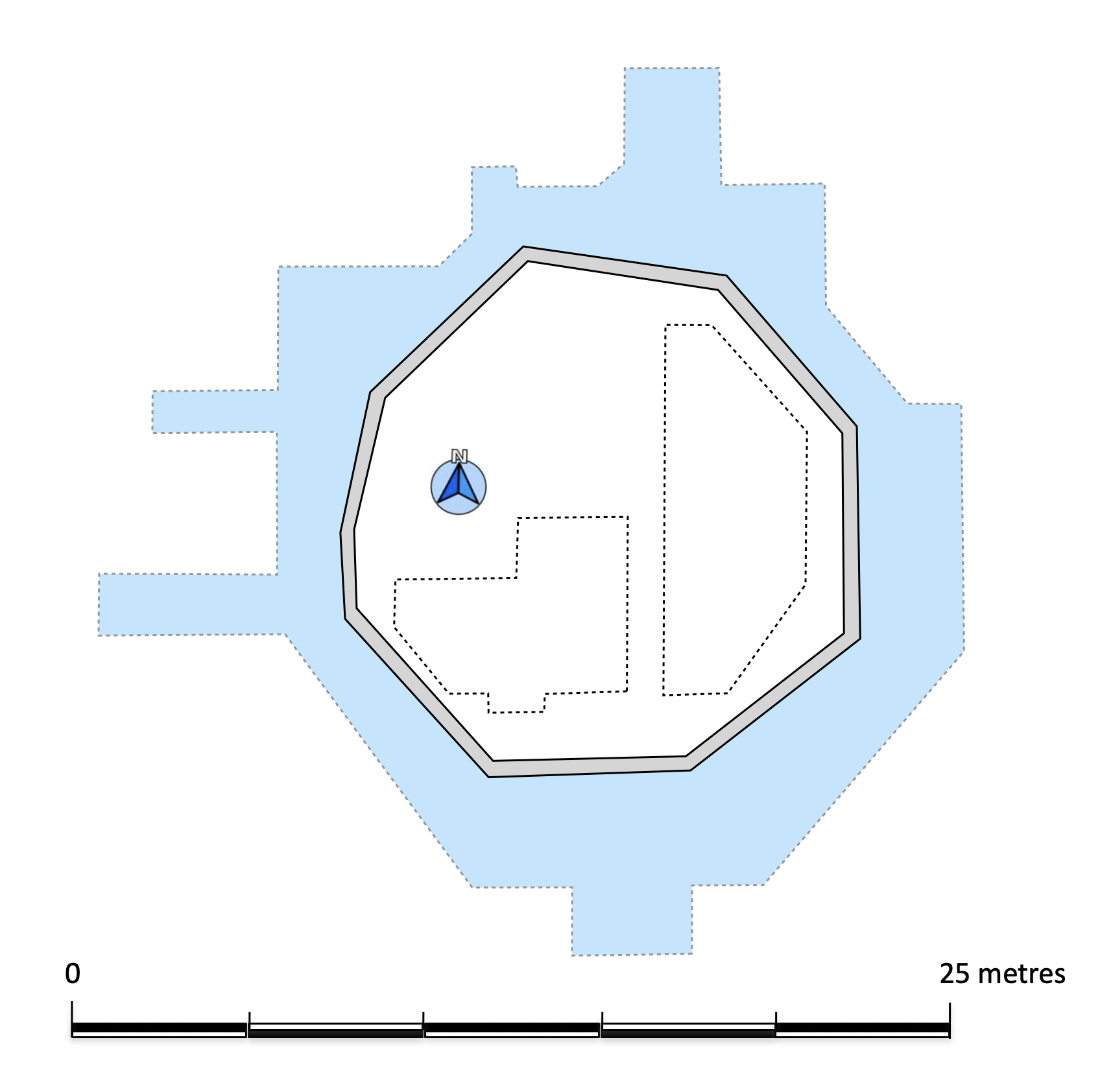
Here's the field drawing and here it is traced up and made clearer, what is going on?
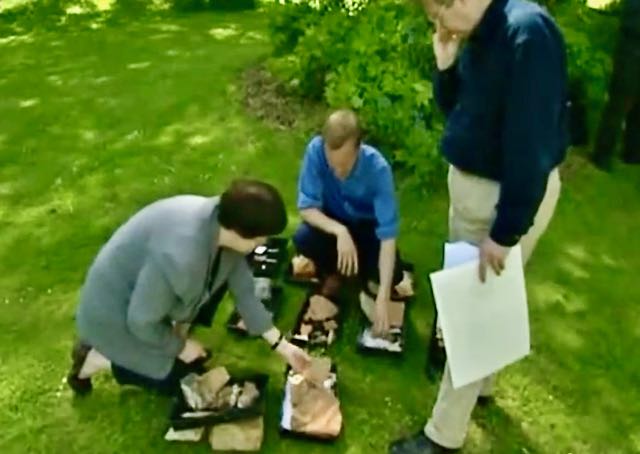


Maureen Mellor, Simon Thurley and David Jacques ponder pots whilst a typical Tudor banquet of sweetmeats was prepared in typical Time Team fashion.

Rupert and Ian charged with uncovering rubble walling.
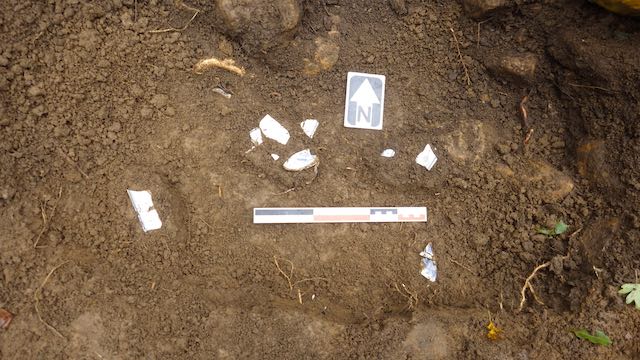
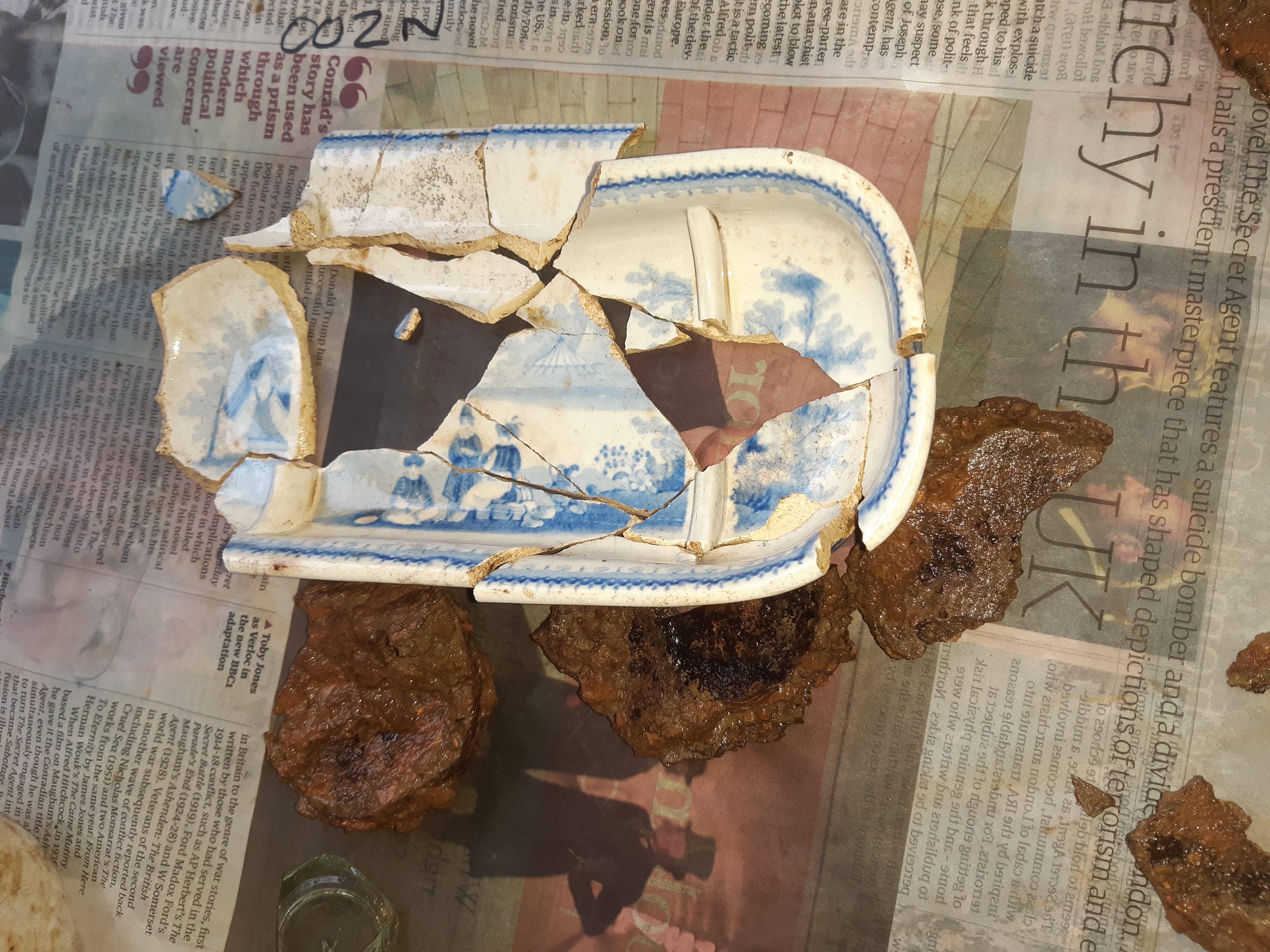
John's excavation of the bits and photo of the whole, well nearly whole (the rest did turn up) box.

We have corners and we have a variety of different forms of walling to investigate further.


We were now in a position to start lifting pots and spiriting them away to the finds department. Jasmine is cleaning round pot 37, could it be, could it be?

Yes, it was not only complete but intact, after being tossed into the moat nearly 350 years ago. As it happened Rowena, Christopher and a delegation from Banbury Museum were on hand to see it lifted.
(There's a movie of this moment on the Polyolbion Instagram account.)

Here it is cleaned up.


The procedure was pretty standardised by now: clean the pot, plan the pot, photograph the pot and lift the pot. Here are Maria and Pinelopi getting on with it.
There
are always new discoveries to be made
amongst the documents as well as on
the ground, here's the text of an
email I sent to Rowena after a late
night reading of Plot:
"I must have read and reread Plot umpteen times but just today I came across this extraordinary line that helps give some kind of context to the ‘New Atlantis’ reference, I think the first time I read it I hadn’t realized that Tangley was one of the Cope family properties. Here’s the quote with my preamble:
"I must have read and reread Plot umpteen times but just today I came across this extraordinary line that helps give some kind of context to the ‘New Atlantis’ reference, I think the first time I read it I hadn’t realized that Tangley was one of the Cope family properties. Here’s the quote with my preamble:
By
1654 they were back at
Tangley where their
third son and first daughter,
who were both to survive
infancy but die at the ages of
7 and 15 respectively, were
born. In 1658 as part of
continuing litigation arising
from an unpaid loan from
Milton 20 years earlier it was
recorded that Sir Anthony,
‘has hired the house at
Tangley to live in with his
family and pays £30 a year
rent for it’. One of the
most remarkable and
tantalising references to
Tangley comes in Plot’s Natural
History of Oxfordshire where,
in giving an account of stones
he termed Brontiae,
he identifies, ‘a
Learned Society of Virtuosi,
that, During the late
Usurpation lived obscurely
at Tangley’. (Plot,
p. 92)
Who
are the members of this
learned society and why
are they living in
obscurity chez Sir
Anthony?" …, more to
follow I’m sure.

A site of special interest, Tangley with the earthworks of what must be another one of the Cope's gardens.
Another
task that had been put off until a reasonably
dry day, with lots of helping hands around, was
a survey of the overall site plan showing the
limits of the excavation and the exact shape of
the octagon. With the assistance of Ian, John
and Liz this was carried out by off-setting with
plenty of tape swinging and the result was so
surprising that we checked everything twice and
then confirmed the plan with additional
measurements across diagonals and around the
perimeter. As octagons go this particular
polygon was far from being a paragon. In fact it
is a real struggle to conjure up a scenario
where such incompetence in laying out would be
permitted. Of course there could have been some
movement on the ground to throw things out a
little but... well, take a look:

The crack tape crew in action working hard to produce:


Here's the field drawing and here it is traced up and made clearer, what is going on?
I've been
corresponding with a number of specialists on
the subject of the Hanwell pots and had a very
helpful reply from Maureen Mellor, the doyenne
of Oxfordshire pottery, who clued me in on a
discovery made during the 2001
Time Team dig at Rycote where amongst
other things they discovered some large
fragments of terra-cotta garden urns. To be fair
I suspect these are early eighteenth century but
interesting nevertheless. I still have to track
down the written report for the full details,



Maureen Mellor, Simon Thurley and David Jacques ponder pots whilst a typical Tudor banquet of sweetmeats was prepared in typical Time Team fashion.
Helping us keep
our heads above water we also had digging
underway along the line of some early walling to
the south east of the main dig. As well as
providing us with the opportunity to make an
unusual find: a nineteenth-century blue and
white transfer printed toothbrush/razor/tooth
pick box, we also came across some significant
structural details to this wall which as always
will take more careful investigation before we
attempt to come up with an explanation.

Rupert and Ian charged with uncovering rubble walling.


John's excavation of the bits and photo of the whole, well nearly whole (the rest did turn up) box.

We have corners and we have a variety of different forms of walling to investigate further.
Considering the
amount of rain we had during the month we all
did extremely well to keep going and do some
really great archaeology, however, as October
faded into November and the news channels were
busy with talk about further lock-downs work on
site for the immediate future looked
increasingly problematic...